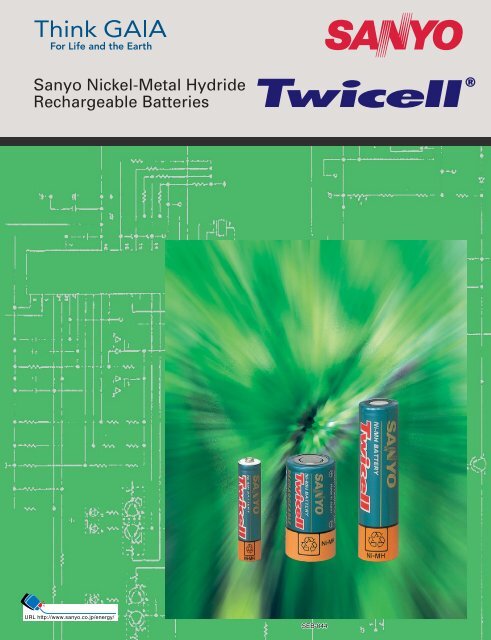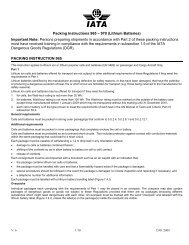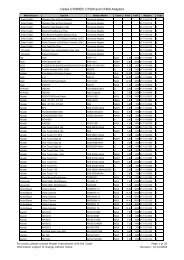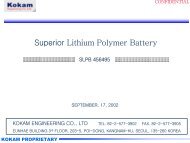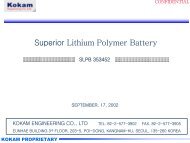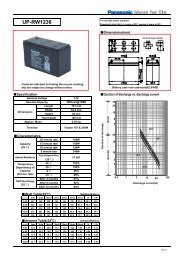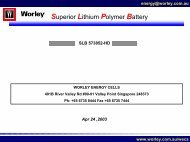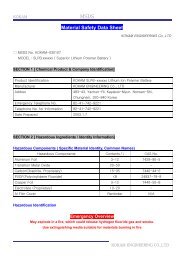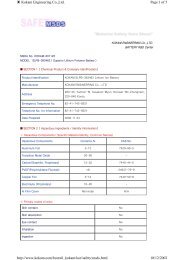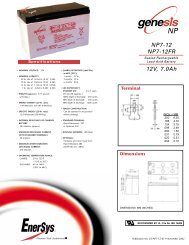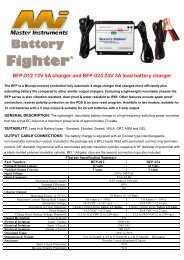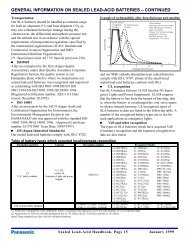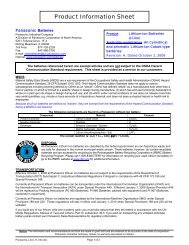Sanyo Nickel-Metal Hydride Rechargeable Batteries - Master ...
Sanyo Nickel-Metal Hydride Rechargeable Batteries - Master ...
Sanyo Nickel-Metal Hydride Rechargeable Batteries - Master ...
Create successful ePaper yourself
Turn your PDF publications into a flip-book with our unique Google optimized e-Paper software.
<strong>Sanyo</strong> <strong>Nickel</strong>-<strong>Metal</strong> <strong>Hydride</strong><br />
<strong>Rechargeable</strong> <strong>Batteries</strong><br />
URL http://www.sanyo.co.jp/energy/<br />
SEB-044
Twicell <strong>Batteries</strong> Handling Precautions<br />
Carefully read this instruction manual before using Twicell batteries for the first time.<br />
Important:For your safety and that of your customers observe all cautionary information provided in<br />
this manual. Save this manual for future reference. The following information is intended to highlight<br />
potential safety hazards that can be associated with the misuse, misapplication or damage to Twicell<br />
batteries. Please carefully evaluate the information in this section when using Twicell batteries (single<br />
cell or packed cells) or when using or manufacturing equipment incorporating Twicell batteries.<br />
This manual is no substitute for your independent evaluation of equipment incorporating Twicell batteries.<br />
Customers incorporating Twicell batteries into their equipment must assure that their completed<br />
product has been properly designed, manufactured and tested. End users of equipment incorporating<br />
Twicell batteries should also be provided with sufficient warnings and instructions on their safe operation.<br />
As appropriate, some or all of the following warnings and information should be incorporated by<br />
you into the instruction manual accompanying your equipment.<br />
1<br />
DANGER!<br />
Failure to carefully observe the following procedures<br />
and precautions can result in leakage of battery<br />
fluid (electrolyte), heat generation, bursting,<br />
fire and serious personal injury!<br />
Never dispose of Twicell batteries in a fire or heat<br />
them.<br />
Doing so may melt the insulation, damage the gas<br />
release vents or protective devices, ignite hydrogen<br />
gas, cause leakage of battery fluid (electrolyte),<br />
heat generation, bursting and fire.<br />
Do not connect the (positive) and (negative)<br />
terminals of Twicell batteries together with electrically<br />
conductive materials, including lead wires. Do<br />
not transport or store Twicell batteries with their<br />
uncovered terminals or connected with a metal<br />
necklace or other conductive material. Doing so<br />
may short circuit a battery, which would result in<br />
excessive current flow and possibly cause leakage<br />
of battery fluid, heat generation, bursting and fire.<br />
When carrying or storing batteries, use a special<br />
case.<br />
Only charge Twicell batteries using those specific<br />
chargers that satisfy <strong>Sanyo</strong>'s specifications. Only<br />
charge batteries under the conditions specified by<br />
<strong>Sanyo</strong>. Failure to follow proper charging procedures<br />
may cause excessive current flow, loss of<br />
control during charging, leakage of battery fluid,<br />
heat generation, bursting and fire.<br />
Never disassemble Twicell batteries. Doing so<br />
may cause an internal or external short circuit or<br />
result in exposed material of battery reacting<br />
chemically with the air. It may also cause heat<br />
generation, bursting and fire. Also, this is dangerous<br />
as it may cause splashing of alkaline fluid.<br />
Never modify or reconstruct Twicell batteries.<br />
Protective devices to prevent danger are built into<br />
batteries(single cell or packed cells). If these are<br />
damaged, excessive current flow may cause loss<br />
of control during charging or discharging of the battery,<br />
leakage of battery fluid, heat generation,<br />
bursting and fire.<br />
Never solder lead wires directly on to Twicell batteries.<br />
The heat of the soldering operation may melt the<br />
insulation, damage the gas release vents or protective<br />
devices, cause leakage of battery fluid, heat<br />
generation, bursting and fire.<br />
The (positive) and (negative) terminals of Twicell<br />
batteries are predetermined. Do not force the<br />
terminal connection to a charger or equipment. If<br />
the terminals can not be easily connected to the<br />
charger or equipment, check if the and terminals<br />
are correctly positioned. If the terminals are<br />
reversed, during charging the battery may be discharged<br />
rather than charged. Furthermore, reversed<br />
connections may cause abnormal chemical<br />
reaction in the battery, the flow of abnormal currents,<br />
leakage of battery fluid, heat generation,<br />
bursting and fire.<br />
The gas release vent which release internal gas is<br />
located in the positive terminal of the Twicell battery.<br />
For this reason, never deform this section or<br />
cover or obstruct its gas release structure. If this<br />
section is deformed or covered or obstructed, the<br />
gas release vent will not function properly, possibly<br />
causing leakage of battery fluid, heat generation,<br />
bursting and fire.<br />
Do not directly connect Twicell batteries to a direct<br />
power source or the cigarette lighter socket in<br />
a car. High voltage may cause excessive current<br />
flow, leakage of battery fluid, heat generation,<br />
bursting and fire.<br />
Do not use Twicell batteries in any equipment<br />
other than those specified by <strong>Sanyo</strong>. Depending<br />
on the equipment being used, doing so may cause<br />
abnormal current flow, leakage of battery fluid,<br />
heat generation, bursting and fire.<br />
Twicell batteries contain the strong colorless alkaline<br />
solution(electrolyte). The alkaline solution is<br />
extremely corrosive and will cause skin damage. If<br />
any fluid from Twicell battery comes in contact with<br />
a user's eyes, they should immediately flush their<br />
eyes and wash them thoroughly with clean water<br />
enough from the tap or another source and consult<br />
a doctor urgently. The strong alkaline solution can<br />
damage eyes and lead to permanent loss of eyesight.<br />
When Twicell batteries are to be incorporated in<br />
equipment or housed within a case, avoid air-tight<br />
structures as this may lead to the equipment or<br />
case being damaged or may be harmful to users.<br />
WARNING!<br />
Do not apply water, seawater or other oxidizing<br />
reagents to Twicell batteries, as this can cause rust<br />
and heat generation. If a battery becomes rusted,<br />
the gas release vent may no longer operate, and<br />
can result in bursting.<br />
Do not connect more than 21 Twicell batteries in<br />
series, as this may cause electrical shocks, leakage<br />
of battery fluid and heat generation.<br />
Keep Twicell batteries or the equipment out of<br />
the reach of babies and small children, in order to<br />
avoid them to swallow batteries. In the event the<br />
batteries are swallowed, consult a doctor immediately.<br />
Do not charge or use Twicell batteries with the <br />
and terminals reversed. Charging batteries with<br />
the terminals reversed may discharge rather than<br />
charge the batteries, or it may cause abnormal<br />
chemical reaction in the batteries. Using batteries<br />
with the terminals reversed may discharge with of<br />
abnormal current, leakage of battery fluid, heat<br />
generation, bursting and fire.<br />
Do not over-charge Twicell batteries by exceeding<br />
the predetermined charging period specified by<br />
the battery charger's instructions or indicator. If<br />
Twicell batteries are not fully charged after the battery<br />
charger's predetermined charging period has<br />
elapsed, stop the charging process. Prolonged<br />
charging may cause leakage of battery fluid, heat<br />
generation, bursting. Be sure to handle recharged<br />
batteries carefully as they may be hot.<br />
Do not remove the outer tube from a battery or<br />
damage it. Doing so will expose the battery to the<br />
risk of a short circuit, and may cause leakage of<br />
battery fluid, heat generation, bursting and fire.<br />
If Twicell batteries leak fluid, change color,<br />
change shape, or change in any other way, do not<br />
use them, otherwise they may cause heat generation,<br />
bursting and fire.<br />
Twicell batteries contain the strong colorless alkaline<br />
solution(electrolyte). If the skin or clothing<br />
comes in contact with fluid from Twicell battery,<br />
thoroughly wash the area immediately with clean<br />
water from the tap or another source. Battery fluid<br />
can irritate the skin.<br />
When the operating time of a Twicell battery becomes<br />
much shorter than its initial operating time<br />
even after recharged, it should be replaced to a<br />
new battery as its battery life has ended.<br />
CAUTION!<br />
Do not strike or drop Twicell batteries. Sharp impacts<br />
or concussions to Twicell batteries may<br />
cause leakage of battery fluid, heat generation,<br />
bursting and fire.<br />
Store Twicell batteries out of the reach of babies<br />
and small children. When charging or using a battery,<br />
do not let babies or small children remove the<br />
battery from the charger or the equipment being<br />
used.<br />
Children should not use Twicell batteries unless<br />
they have been carefully instructed on the contents<br />
of this instruction manual and their parents or guardians<br />
have confirmed that the children understand<br />
and appreciate the proper usage and safety hazards<br />
presented by the batteries.<br />
Be sure to charge Twicell batteries within a temperature<br />
range of 0 to 40 o C(degrees Celsius).<br />
When used at temperatures outside this range(0 to<br />
40 o C) the batteries may cause leakage of battery<br />
fluid or heat generation. It could also impair performance<br />
or shorten service life of Twicell batteries.<br />
Do not charge Twicell battery when it has been<br />
cooled to 0 o C or below. Doing so may cause leakage<br />
of battery fluid, impair performance or shorten<br />
operating life of Twicell batteries.<br />
Do not use or store battery at high temperature,<br />
such as in strong direct sunlight, in cars during hot<br />
weather, or directly in front of a heater. This may<br />
cause leakage of battery fluid. It could also impair<br />
performance and shorten operating life of Twicell<br />
batteries.<br />
Do not use old and new batteries mixed together,<br />
or batteries at different charge levels. Do not use<br />
the Twicell battery mixed together with a dry cell or<br />
other battery of different capacity, type, or brand<br />
name. This may cause leakage of battery fluid and<br />
heat generation.<br />
When more than two batteries are to be used together,<br />
charge them simultaneously prior to use. If<br />
they are not charged at the same time, it could<br />
cause leakage of battery fluid and heat generation.<br />
Do not connect Twicell batteries in parallel as<br />
this may cause leakage of battery fluid, heat generation,<br />
bursting and fire.<br />
For the recommended charging method for Twicell<br />
batteries, read the battery charger's instruction<br />
manual carefully.<br />
If Twicell batteries do not perform or function well<br />
with certain equipment, refer to the instruction<br />
manual or warnings of the subject equipment.<br />
Do not charge Twicell batteries beyond the recommended<br />
time described in the instruction manual<br />
for charger or equipment. Over charging cause<br />
leakage of battery fluid, heat generation, bursting<br />
and fire. It could also impair performance and<br />
shorten service life of Twicell batteries.<br />
After long term storage, there is a possibility that<br />
the battery could not be fully charged. In order to<br />
fully charge it, charge and discharge the battery for<br />
a few times.<br />
Be sure to turn off the equipment after use of<br />
Twicell batteries, as this may result in leakage of<br />
battery fluid.<br />
After they have been removed from equipment,<br />
store Twicell batteries in a dry place and within the<br />
recommended storage temperature range. This<br />
will help preserve the batteries' performance and<br />
durability and to minimize the possibility of leakage<br />
of battery fluid or corrosion. (For the indicated storage<br />
temperature range, refer to the rating table of<br />
this catalog. <strong>Sanyo</strong> recommends a temperature<br />
range from -20 to 30 o C for longer service life).<br />
Before using the Twicell, be sure to read the operation<br />
manual and all precautions carefully, then<br />
store the manual and precautions carefully to use<br />
as reference when the need arises. If you have<br />
specific questions about the operation manual or<br />
the precautions, contact <strong>Sanyo</strong> at the location listed<br />
on the last page of this manual.<br />
If corrosion, heat generation or other abnormalities<br />
with new Twicell batteries are detected. Immediately<br />
stop using them and return them to the<br />
store that they were purchased from.<br />
If the Twicell battery terminals become dirty,<br />
clean them with a soft dry cloth prior to use. Dirt<br />
on the terminals can result in poor contact with the<br />
equipment, loss of power, or inability to charge.
The name "Twicell" derives from that it can be used for approximately twice as long as our standard Cadnica<br />
(<strong>Nickel</strong>-Cadmium) battery after one charging.<br />
-High Capacity, Quick Charging, Greater Reliability-<br />
Twicell Provides Powerful Support for High-Tech Equipment.<br />
SANYO named its high-performance nickel-metal hydride rechargeable batteries "Twicell", a name to suggest their outstanding<br />
characteristics. Twicell batteries last twice as long as SANYO's standard Cadnica [nickel-cadmium] batteries from a single charging cycle.<br />
In 1990, SANYO began the mass-production of Twicell batteries. Now Twicell batteries are one of the keys for the downsizing and<br />
advanced functions of high-tech equipment.<br />
Twicell batteries use a positive electrode made of a nickel oxide compound and a negative electrode made of a hydrogen absorbing alloy.<br />
These sophisticated materials combine with SANYO's proprietary technology to ensure unbeatably high performance and dependability. As<br />
a result, Twicell batteries have been a top seller right from the start. And now an extended Twicell line accommodates a broader range of<br />
applications.<br />
Rapid Charging Capability<br />
When a specifically designed charger is used, Twicell<br />
batteries can be charged in only 1.1 hours . A charge<br />
control module is also available.<br />
Needs special charge control circuit.<br />
High Capacity<br />
SANYO's pursuit of higher capacity has increased<br />
Twicell capacity up nearly twice as high as standard<br />
Cadnica batteries, meaning Twicell batteries work much<br />
longer. This performance makes Twicell an effective<br />
power source for many kinds of high-tech equipment.<br />
High Reliability<br />
SANYO's advanced manufacturing technology and strict<br />
quality control are the secrets behind the outstanding<br />
reliability of Twicell.<br />
2
High Cost Performance, Stable Discharge Voltage<br />
Powerful Twicell<br />
Principle of the <strong>Nickel</strong>-<strong>Metal</strong> <strong>Hydride</strong><br />
Battery<br />
The nickel-metal hydride battery makes electrochemical use<br />
of the reversibility of the hydrogen absorption/release<br />
reaction in the hydrogen absorbing alloy. The battery uses a<br />
nickel oxide compound for the positive electrode, a hydrogen<br />
absorbing alloy for the negative electrode, and an aqueous<br />
alkaline solution for the electrolyte, which includes such<br />
constituents as potassium hydroxide (KOH). During<br />
charging, the electrolytic reaction of water causes the<br />
hydrogen, which forms in atomic form on the surface of the<br />
hydorgen absorbing alloy in the negative electrode, to<br />
diffuse into and be absorbed by the alloy (charge reaction).<br />
During discharge, the absorbed hydrogen reacts with<br />
hydroxide ions at the surface of the hydrogen absorbing<br />
alloy to once again become water (discharge reaction). In<br />
other words, the active material of the negative electrode<br />
reaction is hydrogen, and the hydrogen absorbing alloy acts<br />
as a storage medium for the active material. <strong>Sanyo</strong> has<br />
developed a hydrogen absorbing alloy, which absorbs a<br />
large quantity of hydrogen at low pressure and which can<br />
also release it. <strong>Sanyo</strong> employs this alloy in the Twicell.<br />
Features of Twicell <strong>Batteries</strong><br />
Extended service life and superior economy<br />
Despite discharge capacity that is virtually equal to that of<br />
conventional dry cells, <strong>Sanyo</strong> Twicell batteries feature<br />
minimal internal resistance and exhibit excellent discharge<br />
characteristics under high-rate discharge current conditions.<br />
With output power much higher than that of dry cells. In<br />
addition, even though the batteries are stored for a long time,<br />
the original capacity is almost recovered by repeated<br />
charging/discharging, offering excellent storage<br />
characteristics.<br />
Wide-ranging lineup and interchangeability with<br />
dry cells<br />
Customized assembled batteries tailored to specific<br />
equipment space requirements are also available.<br />
Excellent high-rate discharge performance and<br />
overcharge/overdischarge capability<br />
<strong>Sanyo</strong>'s original electrode manufacturing process and current<br />
collectors minimize internal resistance, which in turn enables<br />
high-rate discharging and guarantees stable discharge<br />
voltage.<br />
Structural Design<br />
Positive terminal<br />
(with built-in gas release vent)<br />
Cover plate<br />
Gasket<br />
Positive<br />
current<br />
collector<br />
Casing<br />
( negative<br />
terminal)<br />
Negative<br />
current<br />
collector<br />
Spring<br />
Seal plate<br />
Rubber plate<br />
Positive electrode<br />
insulation washer<br />
Separator<br />
Negative electrode<br />
Positive electrode<br />
Improved reliability with wide operating<br />
temperature and humidity ranges<br />
In addition to displaying only minimal variation in performance<br />
over a wide temperature range, their totally-sealed<br />
construction gives Twicell batteries high resistance to<br />
humidity. <strong>Sanyo</strong> Twicell batteries are manufactured under<br />
strict quality control conditions, and undergo 100% inspection<br />
before shipment. This assures superior reliability.<br />
Simple to maintain and strong<br />
The special sealed construction eliminates the need to<br />
replenish the electrolyte, for easier maintenance. As <strong>Sanyo</strong><br />
Twicell batteries may be installed in any direction in<br />
equipment, they are exceptionally easy to handle. Moreover,<br />
Twicell batteries employ a rigid metal casing for superior<br />
resistance to shock and vibration.<br />
3
Twicell Line up<br />
A broad range of Twicell is available. Twicell significantly contributes to the compact, lightweight, multi-function<br />
and low-cost features of various portable equipment<br />
High capacity Twicell<br />
For communication equipment,<br />
notebook computers, etc<br />
High-rate discharge Twicell<br />
For power tools, electric motor<br />
applications, etc<br />
Dry cell compatible Twicell<br />
For digital cameras,<br />
audio equipment, etc<br />
High durability Twicell<br />
For cordless phones, razors,<br />
power back-up uses, etc<br />
4
High Cost Performance,<br />
High Energy Density<br />
Features<br />
High capacity<br />
High capacity Twicell has shown the high energy density by using<br />
newly developed materials and constitution. High capacity Twicell<br />
can contribute to prolonging the running time of the equipment.<br />
Rapid charging capability<br />
When a specifically designed charger is used, Twicell batteries can<br />
be charged in only 1.1 hours . A charge control module is also<br />
available.<br />
Needs special charge control circuit.<br />
A broad range<br />
A broad range of high capacity Twicell is available. High capacity<br />
Twicell is ideal for more compact, efficient applications.<br />
Use<br />
For 2-way radios and other communication devices.<br />
For notebook computers, etc.<br />
High Capacity Twicell<br />
<br />
<br />
<br />
<br />
<br />
<br />
<br />
<br />
<br />
<br />
<br />
<br />
<br />
<br />
<br />
<br />
<br />
<br />
<br />
<br />
<br />
<br />
<br />
<br />
<br />
<br />
<br />
<br />
<br />
<br />
<br />
<br />
<br />
<br />
<br />
<br />
<br />
<br />
<br />
<br />
<br />
<br />
<br />
<br />
<br />
<br />
<br />
<br />
<br />
<br />
<br />
<br />
<br />
<br />
<br />
<br />
<br />
<br />
<br />
<br />
<br />
<br />
<br />
<br />
<br />
<br />
<br />
<br />
<br />
<br />
<br />
<br />
<br />
<br />
<br />
<br />
<br />
<br />
<br />
<br />
<br />
<br />
<br />
<br />
<br />
<br />
<br />
<br />
<br />
<br />
<br />
<br />
<br />
<br />
<br />
<br />
Cylindrical type<br />
<br />
<br />
Model No.<br />
<br />
<br />
<br />
<br />
<br />
<br />
<br />
<br />
<br />
<br />
<br />
<br />
<br />
<br />
<br />
<br />
<br />
<br />
<br />
<br />
<br />
<br />
<br />
Voltage Minimum Capacity Quick-Charge Weight<br />
1 2 Current(mA) Diameter(D) Height(H) (approx.g) <br />
<br />
<br />
<br />
<br />
<br />
<br />
<br />
<br />
<br />
<br />
<br />
<br />
<br />
<br />
<br />
<br />
<br />
<br />
<br />
<br />
Notes<br />
5<br />
1 Typical capacity when a single cell is discharged at 0.2It after being charged at 0.1It for 16 hours.<br />
2 Minimum capacity when a single cell is discharged at 0.2It after being charged at 0.1It for 16 hours. 3 Consult <strong>Sanyo</strong> according to conditions of use. 4 Including tube.
Superior Reliability<br />
and Stable Characteristics<br />
Features<br />
Superior service life<br />
High durability Twicell realizes superior service life than high<br />
capacity Twicell at continuous low-rate charging and charge and<br />
discharge cycles. High durability Twicell offers better performance<br />
for cordless phones, power back-up uses, etc.<br />
A powerful range<br />
A broad range of high durability Twicell is available. High durability<br />
Twicell is available for many applications.<br />
Newly developed "T series" realizes higher durability than<br />
conventional "C series" for emergency lights, etc.<br />
Use<br />
T series : For emergency lights, power back-up uses, etc.<br />
C series : For cordless phones, razors, power back-up uses, etc.<br />
<br />
<br />
Cylindrical type<br />
<br />
<br />
Model No.<br />
<br />
Voltage Minimum Capacity Quick-Charge Weight<br />
High Durability Twicell<br />
<br />
<br />
<br />
<br />
<br />
<br />
<br />
<br />
<br />
<br />
<br />
<br />
<br />
<br />
<br />
<br />
<br />
<br />
<br />
<br />
<br />
<br />
<br />
<br />
<br />
<br />
<br />
<br />
<br />
<br />
<br />
<br />
<br />
<br />
<br />
<br />
<br />
<br />
<br />
<br />
<br />
<br />
<br />
<br />
<br />
<br />
<br />
<br />
<br />
<br />
<br />
<br />
<br />
<br />
<br />
<br />
<br />
<br />
<br />
<br />
<br />
<br />
<br />
<br />
<br />
<br />
<br />
<br />
<br />
<br />
<br />
<br />
<br />
<br />
<br />
1 2 Current(mA) Diameter(D) Height(H) (approx.g) <br />
<br />
<br />
<br />
<br />
<br />
<br />
<br />
Model No.<br />
1 2 Current(mA) Diameter(D) Height(H) (approx.g) <br />
<br />
<br />
<br />
<br />
<br />
<br />
<br />
<br />
<br />
<br />
<br />
<br />
<br />
<br />
<br />
<br />
<br />
<br />
Voltage Minimum Capacity Quick-Charge Weight<br />
<br />
<br />
<br />
<br />
<br />
<br />
<br />
<br />
<br />
<br />
<br />
<br />
<br />
<br />
<br />
<br />
<br />
<br />
<br />
<br />
<br />
<br />
<br />
Notes<br />
Notes<br />
<br />
<br />
<br />
1 Typical capacity when a single cell is discharged at 0.2It after being charged at 0.1It for 16 hours. 2 Minimum capacity when a single cell is discharged at 0.2It after being charged at 0.1It for 16 hours.<br />
3 Consult <strong>Sanyo</strong> according to conditions of use. 4 Including tube. 5 With paper tube. Other cells are with heat shrink tube.<br />
6
Stable Discharge Voltage<br />
at High-rate Discharge<br />
High-rate Discharge Twicell<br />
Features<br />
Superior high-rate discharge characteristics<br />
<strong>Sanyo</strong>'s original electrode manufacturing process and current<br />
collectors minimize internal resistance, which in turn enables highrate<br />
discharging and guarantees stable discharge voltage.<br />
Improved reliability with wide operating temperature<br />
In addition to displaying only minimal variation in performance over<br />
a wide temperature range.<br />
A powerful range<br />
High-rate discharge Twicell consists of wide variation. It enables to<br />
be used many applications.<br />
Use<br />
For power tools, cordless cleaners, electric motor applications,<br />
power back-up uses, etc.<br />
<br />
<br />
<br />
<br />
<br />
<br />
<br />
<br />
<br />
<br />
<br />
<br />
<br />
<br />
<br />
<br />
<br />
<br />
<br />
<br />
<br />
<br />
<br />
<br />
<br />
<br />
<br />
<br />
<br />
<br />
<br />
<br />
<br />
<br />
<br />
<br />
<br />
<br />
<br />
<br />
<br />
<br />
<br />
<br />
<br />
<br />
<br />
<br />
<br />
<br />
<br />
<br />
<br />
<br />
<br />
<br />
<br />
<br />
<br />
<br />
<br />
<br />
<br />
<br />
<br />
<br />
<br />
<br />
<br />
<br />
<br />
<br />
<br />
<br />
<br />
<br />
<br />
<br />
<br />
<br />
<br />
<br />
<br />
<br />
Cylindrical type<br />
<br />
<br />
Model No.<br />
<br />
<br />
<br />
<br />
<br />
<br />
<br />
<br />
<br />
<br />
<br />
<br />
<br />
<br />
Voltage Minimum Capacity Quick-Charge Weight<br />
1 2 Current(mA) Diameter(D) Height(H) (approx.g) <br />
<br />
<br />
<br />
<br />
<br />
<br />
<br />
<br />
<br />
<br />
<br />
<br />
<br />
<br />
<br />
<br />
<br />
<br />
<br />
<br />
<br />
<br />
<br />
<br />
<br />
<br />
<br />
<br />
<br />
<br />
<br />
<br />
<br />
<br />
<br />
<br />
<br />
<br />
<br />
<br />
<br />
<br />
<br />
<br />
<br />
<br />
<br />
<br />
<br />
<br />
<br />
<br />
<br />
<br />
<br />
<br />
<br />
Notes<br />
<br />
<br />
<br />
<br />
<br />
<br />
<br />
<br />
<br />
7<br />
1 Typical capacity when a single cell is discharged at 0.2It after being charged at 0.1It for 16 hours. 2 Minimum capacity when a single cell is discharged at 0.2It after being charged at 0.1It for 16 hours.<br />
3 Consult <strong>Sanyo</strong> according to conditions of use. 4 Including tube. 5 With paper tube. Other cells are with heat shrink tube.
Dry Cell Compatible Twicell<br />
High Capacity and Convenience<br />
Features<br />
Dry cell compatible shape<br />
Dry cell compatible Twicell can be used for most of equipment<br />
using AA and AAA size dry cells.<br />
Top level capacity in retail use rechargeable battery.<br />
The equipment which need the high capacity like the digital camera<br />
is suitable.<br />
Long charge/dischargecycle life as well as offering<br />
outstanding economy<br />
Twicell can reduce waste (the amount of used batteries) than that<br />
of dry cell.<br />
A powerful range<br />
with low self-discharge and high discharge voltage is<br />
developed.<br />
Use<br />
Portable charger which can charge<br />
AA/AAA size batteries at a time quickly<br />
and have auto voltage function for<br />
AC100V-240V<br />
The charger for<br />
<strong>Nickel</strong>-<strong>Metal</strong> <strong>Hydride</strong> batteries<br />
NC-MQR02N<br />
Features<br />
NC-MQR02N can charge AA/AAA size <strong>Nickel</strong>-<strong>Metal</strong> <strong>Hydride</strong><br />
batteries at a time.<br />
AA size <strong>Nickel</strong>-<strong>Metal</strong> <strong>Hydride</strong> batteries (HR-3U, Typ.2700mAh type)<br />
: approx. 305min.(four batteries), approx.135min.(two batteries)<br />
AAA size <strong>Nickel</strong>-<strong>Metal</strong> <strong>Hydride</strong> batteries (HR-4U, Typ.1000mAh type)<br />
: approx. 205min.(two batteries)<br />
Newly developed control systems prevent the battery<br />
from overcharging and charging error.<br />
Newly developed peak detection and pulse control systems prevent the<br />
battery from overcharging and charging error. And the light informs the<br />
charging status.<br />
Light weight and compact design.<br />
NC-MQR02N is handy to carry. Weight : approx.95g (except the batteries),<br />
Thickness : 27.5mm. And they have the storage space of plug.<br />
For digital cameras, PDA and audio equipment, remort controller,<br />
clock, etc.<br />
<br />
<br />
<br />
<br />
<br />
<br />
<br />
<br />
<br />
<br />
Cylindrical type<br />
<br />
Model No.<br />
Voltage Minimum Capacity Quick-Charge Weight<br />
1 2 Current(mA) Diameter(D) Height(H) (approx.g) <br />
<br />
<br />
<br />
<br />
<br />
<br />
<br />
<br />
<br />
<br />
<br />
<br />
<br />
Notes<br />
1 Typical capacity when a single cell is discharged at 0.2It after being charged at 0.1It for 16 hours. 2 Minimum capacity when a single cell is discharged at 0.2It after being charged at 0.1It for 16 hours.<br />
3 Consult <strong>Sanyo</strong> according to conditions of use. 4 Including tube.<br />
8
Types and Applications of Twicell <strong>Batteries</strong><br />
Application<br />
Radio Cassette Recorder<br />
Radio<br />
Audio<br />
Head Set Stereo<br />
Mini Disc<br />
Wireless Microphone<br />
Camcorder<br />
Camera<br />
AF Camera<br />
Digital Camera<br />
Remote controller<br />
Remote controller<br />
Notebook Computer<br />
Mini-Notebook Computer, PDA<br />
Potable Printer<br />
Information<br />
Organizer, Calculator<br />
Data Entry<br />
2 Way Radio<br />
Cordless Phone<br />
Communication<br />
Mobile Phone<br />
DECT Phone<br />
Electric Razor<br />
Home Appliance<br />
Vacuum Cleaner<br />
Power Tool<br />
Power Tool<br />
Fire Alarm<br />
Emergency<br />
Emergency lights<br />
Emergency Communicator<br />
Photographic Lighting Equipment<br />
Light<br />
Light<br />
Remote Control Toys<br />
Toy<br />
Game Machine<br />
Medical<br />
Medical Equipment<br />
Construction<br />
Solar-powered Equipment<br />
Transport<br />
Power Assisted Bicycles or Vehicles<br />
Dry Cell-applied Products<br />
Others<br />
Robots, Uninterrupted Power Systems (UPS)<br />
Measuring Instrument<br />
Typical applications are shown in the table. For other purposes, consult <strong>Sanyo</strong>.<br />
<br />
<br />
<br />
<br />
<br />
<br />
<br />
<br />
<br />
<br />
<br />
<br />
<br />
<br />
<br />
<br />
<br />
<br />
<br />
<br />
<br />
<br />
<br />
<br />
<br />
<br />
<br />
<br />
<br />
<br />
<br />
<br />
<br />
<br />
Precautions for Incorporating Assembled <strong>Batteries</strong><br />
When batteries are used at high temperature, their<br />
charge efficiency decreases and degradation of their<br />
performance and material properties is accelerated.<br />
To prevent this, keep the battery away from heat<br />
generating parts such as in transformers, and<br />
attempt to improve the heat diffusion of equipment<br />
and battery.<br />
Reverse charging of battery may cause leakage of<br />
electrolyte (strong alkaline aqueous solution), thus<br />
calling for alkaline-resistant materials in the<br />
periphery of the battery. Together with the<br />
electrolyte, oxygen or hydrogen gas may leak.<br />
During design, measures must be incorporated to<br />
prevent combustion. which may be caused by<br />
sparks from motors or switches.<br />
Avoid contact-type connections such as those<br />
employing a spring, as an oxidized coating will form<br />
on the contact surface after prolonged periods of<br />
use, leading to possible improper contact. If a<br />
contact-type connection is used, remove the battery<br />
and wipe the contact with a cloth every few months<br />
to improve conductivity.<br />
Select the material for the connection plate that has<br />
excellent resistance to alkaline. The materials that<br />
contain copper may cause a trouble like rust.<br />
Avoid direct attachment to a printed board, as<br />
leakage will corrode the board. If direct attachment<br />
is necessary, please consult with <strong>Sanyo</strong><br />
representative.<br />
10
Certified by ISO 9000S<br />
SANYO Electric Group has received<br />
Environmental Management System ISO<br />
14001 certification.<br />
<br />
USA<br />
SANYO Energy (USA) Corporation<br />
TEL :(+1)469-362-5600<br />
FAX:(+1)469-362-5699<br />
New Jersey Office<br />
TEL :(+1)973-256-8923<br />
FAX:(+1)973-256-8375<br />
Florida Office<br />
TEL :(+1)352-376-6711<br />
FAX:(+1)352-376-6772<br />
CANADA<br />
SANYO Canada Inc.<br />
TEL :(+1)905-760-9944<br />
FAX:(+1)905-760-9945<br />
EUROPE<br />
SANYO Component Europe GmbH<br />
TEL :(+49)89-4600950<br />
FAX:(+49)89-460095190<br />
France Office<br />
TEL :(+33)1-4131-8484<br />
FAX:(+33)1-4131-8485<br />
UK Office<br />
TEL :(+44)1923-477479<br />
FAX:(+44)1923-246363<br />
ASIA<br />
SANYO Energy (HK) Company Ltd.<br />
TEL :(+852)2301-2213<br />
FAX:(+852)2301-2191<br />
SANYO Energy (Taiwan) Company Ltd.<br />
TEL :(+886)2-8780-8810<br />
FAX:(+886)2-8780-8850<br />
SANYO Energy (Singapore)<br />
Corporation Pte., Ltd.<br />
TEL :(+65)6736-3100<br />
FAX:(+65)6736-1230<br />
AUSTRALIA<br />
SANYO Oceania Pty. Ltd.<br />
TEL :(+61)2-8825-2822<br />
FAX:(+61)2-9678-9381<br />
SANYO Electric Co., Ltd.<br />
POWER GROUP<br />
Mobile Energy Company<br />
Factory, Sales<br />
Sumoto-city, Hyogo, Japan<br />
TEL:(+81)799-24-4111<br />
FAX:(+81)799-24-4123<br />
For more detailed information, contact the above:<br />
Any and all information described or contained this<br />
brochure are subject to change without notice due to<br />
product / technology improvement, etc.<br />
This brochure was printed on recycle paper.<br />
Printed in Japan 2007.10. 6,000


